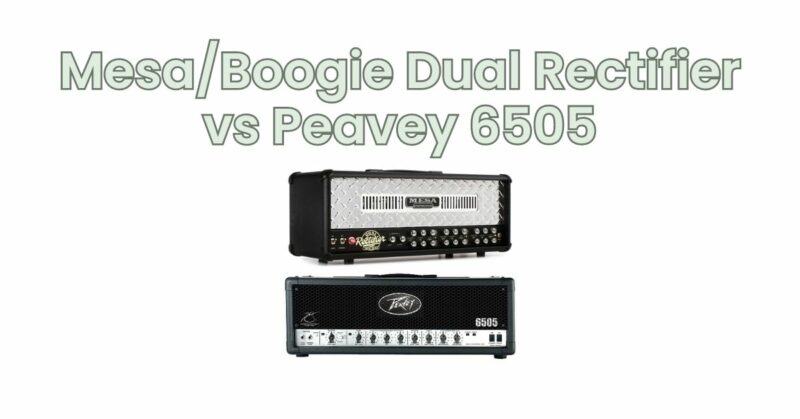For guitarists seeking high-gain, bone-crushing tones, the Mesa/Boogie Dual Rectifier and the Peavey 6505 have long been considered top contenders. These iconic amplifiers have become synonymous with heavy rock and metal genres, providing the aggressive and saturated tones that have shaped countless iconic recordings. In this article, we’ll delve into the features, tonal characteristics, and overall performance of the Mesa/Boogie Dual Rectifier and the Peavey 6505, helping you navigate the world of high-gain amplification and choose the right amplifier for your playing style.
- Mesa/Boogie Dual Rectifier
- Peavey 6505
- Tonal Character:
The Mesa/Boogie Dual Rectifier is renowned for its versatile tonal range, offering both vintage and modern voicings. It features three distinct channels: Clean, Vintage, and Modern. The Clean channel delivers pristine cleans with ample headroom, while the Vintage and Modern channels provide the signature Rectifier high-gain tones. The Vintage channel offers a more classic rock tone with a smoother and more compressed response, while the Modern channel pushes the gain envelope for blistering, tight, and aggressive modern metal tones. The Peavey 6505, formerly known as the 5150, is a no-nonsense high-gain monster. It is built for the heaviest of genres, delivering raw, aggressive, and searing tones. The 6505 features two channels: Rhythm and Lead, both optimized for high-gain mayhem. The Rhythm channel provides chunky, tight rhythms, while the Lead channel offers searing, saturated tones with exceptional note articulation.
- Power and Versatility:
The Mesa/Boogie Dual Rectifier offers varying power options, ranging from 50 to 100 watts, providing plenty of headroom for live performances and studio recording. Its three channels and comprehensive EQ controls allow for a wide range of tonal sculpting. The included rectifier options (Tube, Diode, or Tube + Diode) further add to its versatility, offering different levels of sag and response. The Peavey 6505, available in both 60-watt and 120-watt versions, is designed for high-gain saturation and excels in delivering thick and aggressive tones. While it doesn’t offer as many tonal options as the Dual Rectifier, its straightforward design and focus on high-gain tones make it a favorite among metal guitarists.
- Controls and Features:
The Mesa/Boogie Dual Rectifier provides extensive control over its tonal shaping. Each channel has dedicated gain, treble, mid, bass, presence, and master controls, allowing precise tailoring of your sound. The Rectifier options and a switchable effects loop provide additional flexibility. The Peavey 6505 features independent pre-gain and post-gain controls on each channel, along with a three-band EQ and a resonance control to shape your tone. It also includes a switchable effects loop, ensuring compatibility with your favorite pedals and rack gear.
- Build Quality and Reliability:
Both the Mesa/Boogie Dual Rectifier and the Peavey 6505 are built to withstand the rigors of the road and deliver reliable performance night after night. Mesa/Boogie is renowned for its meticulous craftsmanship and attention to detail, using high-quality components to ensure durability and sonic excellence. Peavey, known for its robust construction, has created the 6505 to withstand the most aggressive playing styles with its solid build and road-worthy reliability.
- Aesthetics:
The Mesa/Boogie Dual Rectifier sports a distinctive design with its rugged metal grille, easy-to-read control layout, and iconic Mesa/Boogie logo. The Peavey 6505, with its classic black tolex, silver control panel, and recognizable logo, exudes a no-nonsense and aggressive aesthetic that perfectly matches its sonic characteristics.
Conclusion:
Choosing between the Mesa/Boogie Dual Rectifier and the Peavey 6505 is a matter of personal preference and the specific sonic characteristics you desire. The Dual Rectifier offers a wide range of tonal options, from pristine cleans to aggressive modern metal tones, while the Peavey 6505 is focused on delivering pure, high-gain aggression. Both amplifiers have been used by countless professional guitarists in the rock and metal genres, so it’s worth trying them out to see which one speaks to you and your playing style. Whether you opt for the versatile tones of the Dual Rectifier or the straightforward, raw power of the 6505, both amplifiers will satisfy your hunger for high-gain mayhem and provide a solid foundation for your sonic exploration.


